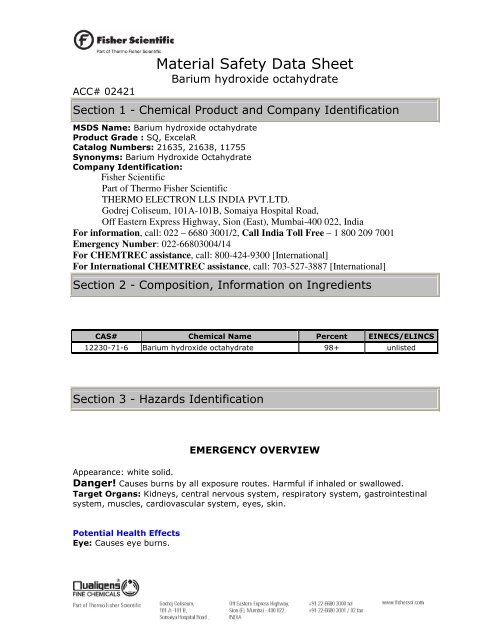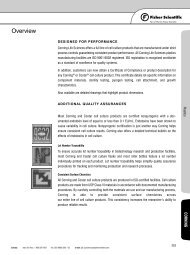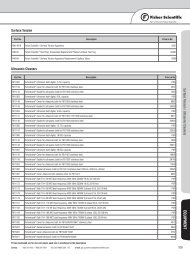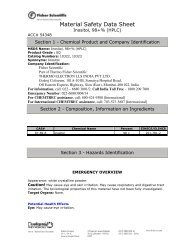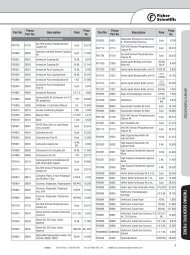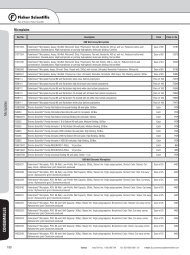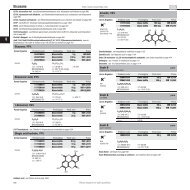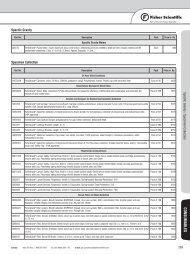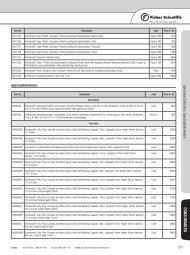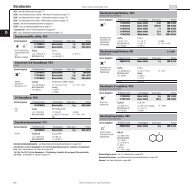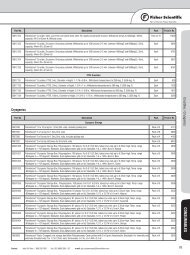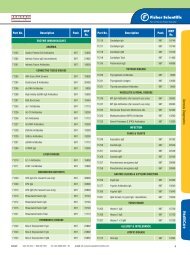Material Safety Data Sheet - Fisher Scientific: Lab Equipment
Material Safety Data Sheet - Fisher Scientific: Lab Equipment
Material Safety Data Sheet - Fisher Scientific: Lab Equipment
You also want an ePaper? Increase the reach of your titles
YUMPU automatically turns print PDFs into web optimized ePapers that Google loves.
ACC# 02421<br />
<strong>Material</strong> <strong>Safety</strong> <strong>Data</strong> <strong>Sheet</strong><br />
Barium hydroxide octahydrate<br />
Section 1 - Chemical Product and Company Identification<br />
MSDS Name: Barium hydroxide octahydrate<br />
Product Grade : SQ, ExcelaR<br />
Catalog Numbers: 21635, 21638, 11755<br />
Synonyms: Barium Hydroxide Octahydrate<br />
Company Identification:<br />
<strong>Fisher</strong> <strong>Scientific</strong><br />
Part of Thermo <strong>Fisher</strong> <strong>Scientific</strong><br />
THERMO ELECTRON LLS INDIA PVT.LTD.<br />
Godrej Coliseum, 101A-101B, Somaiya Hospital Road,<br />
Off Eastern Express Highway, Sion (East), Mumbai-400 022, India<br />
For information, call: 022 – 6680 3001/2, Call India Toll Free – 1 800 209 7001<br />
Emergency Number: 022-66803004/14<br />
For CHEMTREC assistance, call: 800-424-9300 [International]<br />
For International CHEMTREC assistance, call: 703-527-3887 [International]<br />
Section 2 - Composition, Information on Ingredients<br />
CAS# Chemical Name Percent EINECS/ELINCS<br />
12230-71-6 Barium hydroxide octahydrate 98+ unlisted<br />
Section 3 - Hazards Identification<br />
EMERGENCY OVERVIEW<br />
Appearance: white solid.<br />
Danger! Causes burns by all exposure routes. Harmful if inhaled or swallowed.<br />
Target Organs: Kidneys, central nervous system, respiratory system, gastrointestinal<br />
system, muscles, cardiovascular system, eyes, skin.<br />
Potential Health Effects<br />
Eye: Causes eye burns.
Skin: Causes skin burns. May be harmful if absorbed through the skin.<br />
Ingestion: Harmful if swallowed. Causes gastrointestinal tract burns.<br />
Inhalation: Harmful if inhaled. Causes chemical burns to the respiratory tract.<br />
Chronic: No information found.<br />
Section 4 - First Aid Measures<br />
Eyes: Immediately flush eyes with plenty of water for at least 15 minutes, occasionally<br />
lifting the upper and lower eyelids. Get medical aid imme diately.<br />
Skin: Get medical aid immediately. Immediately flush skin with plenty of water for at<br />
least 15 minutes while removing contaminated clothing and shoes.<br />
Ingestion: Do not induce vomiting. Get medical aid immediately. Call a poison control<br />
center.<br />
Inhalation: Get medical aid immediately. Remove from exposure and move to fresh air<br />
immediately. If breathing is difficult, give oxygen. Do not use mouth-to-mouth<br />
resuscitation if victim ingested or inhaled the substance; induce artificial respiration with<br />
the aid of a pocket mask equipped with a one-way valve or other proper respiratory<br />
medical device.<br />
Notes to Physician: Treat symptomatically and supportively.<br />
Section 5 - Fire Fighting Measures<br />
General Information: As in any fire, wear a self-contained breathing apparatus in<br />
pressure-demand, MSHA/NIOSH (approved or equivalent), and full protective gear.<br />
Extinguishing Media: Use water spray, dry chemical, carbon dioxide, or chemical<br />
foam.<br />
Flash Point: Not applicable.<br />
Autoignition Temperature: Not applicable.<br />
Explosion Limits, Lower:Not available.<br />
Upper: Not available.<br />
NFPA Rating: (estimated) Health: 3; Flammability: 1; Instability: 1<br />
Section 6 - Accidental Release Measures<br />
General Information: Use proper personal protective equipment as indicated in<br />
Section 8.<br />
Spills/Leaks: Vacuum or sweep up material and place into a suitable disposal<br />
container. Wear a self contained breathing apparatus and appropriate personal
protection. (See Exposure Controls, Personal Protection section). Avoid generating dusty<br />
conditions. Provide ventilation. Do not let this chemical enter the environment.<br />
Section 7 - Handling and Storage<br />
Handling: Minimize dust generation and accumulation. Do not get in eyes, on skin, or<br />
on clothing. Do not ingest or inhale. Use only in a chemical fume hood.<br />
Storage: Store in a cool, dry place. Store in a tightly closed container. Corrosives area.<br />
Store under nitrogen.<br />
Section 8 - Exposure Controls, Personal Protection<br />
Engineering Controls: Facilities storing or utilizing this material should be equipped<br />
with an eyewash facility and a safety shower. Use only under a chemical fume hood.<br />
Exposure Limits<br />
Chemical Name ACGIH NIOSH OSHA - Final PELs<br />
Barium hydroxide<br />
octahydrate<br />
Barium hydroxide<br />
anhydrous<br />
0.5 mg/m3 TWA (as<br />
Ba) (listed under<br />
Barium, soluble<br />
compounds).<br />
0.5 mg/m3 TWA (as<br />
Ba) (listed under<br />
Barium, soluble<br />
compounds).<br />
0.5 mg/m3 TWA (as Ba,<br />
except barium sulfate)<br />
(listed under Barium,<br />
soluble compounds).<br />
0.5 mg/m3 TWA (as Ba,<br />
except barium sulfate)<br />
(listed under Barium,<br />
soluble compounds).<br />
0.5 mg/m3 TWA (as<br />
Ba) (listed under<br />
Barium, soluble<br />
compounds).<br />
0.5 mg/m3 TWA (as<br />
Ba) (listed under<br />
Barium, soluble<br />
compounds).<br />
OSHA Vacated PELs: Barium hydroxide octahydrate: No OSHA Vacated PELs are listed<br />
for this chemical. Barium hydroxide anhydrous: No OSHA Vacated PELs are listed for this<br />
chemical.<br />
Personal Protective <strong>Equipment</strong><br />
Eyes: Wear appropriate protective eyeglasses or chemical safety goggles as described<br />
by OSHA's eye and face protection regulations in 29 CFR 1910.133 or European<br />
Standard EN166.<br />
Skin: Wear appropriate protective gloves to prevent skin exposure.<br />
Clothing: Wear appropriate protective clothing to prevent skin exposure.<br />
Respirators: A respiratory protection program that meets OSHA's 29 CFR 1910.134 and<br />
ANSI Z88.2 requirements or European Standard EN 149 must be followed whenever<br />
workplace conditions warrant respirator use.
Section 9 - Physical and Chemical Properties<br />
Physical State: Solid<br />
Appearance: white<br />
Odor: odorless<br />
pH: 12.5 (50 g/L aq. sol.)<br />
Vapor Pressure: Negligible.<br />
Vapor Density: Not available.<br />
Evaporation Rate:Negligible.<br />
Viscosity: Not available.<br />
Boiling Point: Not available.<br />
Freezing/Melting Point:78 deg C<br />
Decomposition Temperature:> 95 deg C<br />
Solubility: 56 g/L (15°C)<br />
Specific Gravity/Density:2.18<br />
Molecular Formula:Ba(OH)2.8H2O<br />
Molecular Weight:315.48<br />
Section 10 - Stability and Reactivity<br />
Chemical Stability: Absorbs carbon dioxide from the air.<br />
Conditions to Avoid: Incompatible materials, dust generation, exposure to air.<br />
Incompatibilities with Other <strong>Material</strong>s: Acids, aluminum.<br />
Hazardous Decomposition Products: Barium oxide.<br />
Hazardous Polymerization: Will not occur.<br />
Section 11 - Toxicological Information<br />
RTECS#:<br />
CAS# 12230-71-6 unlisted.<br />
CAS# 17194-00-2: CQ9200000<br />
LD50/LC50:<br />
Not available.<br />
CAS# 17194-00-2:<br />
Oral, rat: LD50 = 308 mg/kg;<br />
.
Carcinogenicity:<br />
CAS# 12230-71-6: Not listed by ACGIH, IARC, NTP, or CA Prop 65.<br />
CAS# 17194-00-2: Not listed by ACGIH, IARC, NTP, or CA Prop 65.<br />
Epidemiology: No information available.<br />
Teratogenicity: No information available.<br />
Reproductive Effects: No information available.<br />
Mutagenicity: No information available.<br />
Neurotoxicity: No information available.<br />
Other Studies:<br />
Section 12 - Ecological Information<br />
Ecotoxicity: No data available. No information available.<br />
Environmental: No information available.<br />
Physical: No information available.<br />
Other: Do not empty into drains.<br />
Section 13 - Disposal Considerations<br />
Chemical waste generators must determine whether a discarded chemical is classified as<br />
a hazardous waste. US EPA guidelines for the classification determination are listed in 40<br />
CFR Parts 261.3. Additionally, waste generators must consult state and local hazardous<br />
waste regulations to ensure complete and accurate classification.<br />
RCRA P-Series: None listed.<br />
RCRA U-Series: None listed.<br />
Section 14 - Transport Information<br />
US DOT Canada TDG<br />
Shipping Name: CORROSIVE SOLIDS, TOXIC, N.O.S. CORROSIVE SOLIDS, TOXIC, N.O.S.<br />
Hazard Class: 8 8(6.1)<br />
UN Number: UN2923 UN2923<br />
Packing Group: III III
Section 15 - Regulatory Information<br />
US FEDERAL<br />
TSCA<br />
CAS# 12230-71-6 is not on the TSCA Inventory because it is a hydrate. It is<br />
considered to be listed if the CAS number for the anhydrous form is on the inventory<br />
(40CFR720.3(u)(2)).<br />
CAS# 17194-00-2 is listed on the TSCA inventory.<br />
Health & <strong>Safety</strong> Reporting List<br />
None of the chemicals are on the Health & <strong>Safety</strong> Reporting List.<br />
Chemical Test Rules<br />
None of the chemicals in this product are under a Chemical Test Rule.<br />
Section 12b<br />
None of the chemicals are listed under TSCA Section 12b.<br />
TSCA Significant New Use Rule<br />
None of the chemicals in this material have a SNUR under TSCA.<br />
CERCLA Hazardous Substances and corresponding RQs<br />
None of the chemicals in this material have an RQ.<br />
SARA Section 302 Extremely Hazardous Substances<br />
None of the chemicals in this product have a TPQ.<br />
SARA Codes<br />
CAS # 12230-71-6: immediate, delayed.<br />
CAS # 17194-00-2: immediate, delayed.<br />
Section 313<br />
This material contains Barium hydroxide octahydrate (listed as Barium compounds,<br />
n.o.s.), 98+%, (CAS# 12230-71-6) which is subject to the reporting requirements of<br />
Section 313 of SARA Title III and 40 CFR Part 373.<br />
This material contains Barium hydroxide anhydrous (listed as Barium compounds,<br />
n.o.s.), -%, (CAS# 17194-00-2) which is subject to the reporting requirements of<br />
Section 313 of SARA Title III and 40 CFR Part 373.<br />
Clean Air Act:<br />
This material does not contain any hazardous air pollutants.<br />
This material does not contain any Class 1 Ozone depletors.<br />
This material does not contain any Class 2 Ozone depletors.<br />
Clean Water Act:<br />
None of the chemicals in this product are listed as Hazardous Substances under the<br />
CWA.<br />
None of the chemicals in this product are listed as Priority Pollutants under the CWA.<br />
None of the chemicals in this product are listed as Toxic Pollutants under the CWA.<br />
OSHA:<br />
None of the chemicals in this product are considered highly hazardous by OSHA.<br />
STATE<br />
CAS# 12230-71-6 can be found on the following state right to know lists: California,<br />
(listed as Barium, soluble compounds), New Jersey, (listed as Barium compounds,<br />
n.o.s.), Pennsylvania, (listed as Barium compounds, n.o.s.), Minnesota, (listed as<br />
Barium, soluble compounds).
CAS# 17194-00-2 can be found on the following state right to know lists: California,<br />
(listed as Barium, soluble compounds), New Jersey, (listed as Barium compounds,<br />
n.o.s.), Pennsylvania, (listed as Barium compounds, n.o.s.), Minnesota, (listed as<br />
Barium, soluble compounds).<br />
California Prop 65<br />
California No Significant Risk Level: None of the chemicals in this product are listed.<br />
European/International Regulations<br />
European <strong>Lab</strong>eling in Accordance with EC Directives<br />
Hazard Symbols:<br />
C<br />
Risk Phrases:<br />
R 20/22 Harmful by inhalation and if swallowed.<br />
R 34 Causes burns.<br />
<strong>Safety</strong> Phrases:<br />
S 26 In case of contact with eyes, rinse immediately with plenty of<br />
water and seek medical advice.<br />
S 36/37/39 Wear suitable protective clothing, gloves and eye/face pr<br />
otection.<br />
S 45 In case of accident or if you feel unwell, seek medical advice<br />
immediately (show the label where possible).<br />
WGK (Water Danger/Protection)<br />
CAS# 12230-71-6: 1<br />
CAS# 17194-00-2: 1<br />
Canada - DSL/NDSL<br />
CAS# 17194-00-2 is listed on Canada's DSL List.<br />
Canada - WHMIS<br />
This product has a WHMIS classification of D1B, E.<br />
This product has been classified in accordance with the hazard criteria of the Controlled<br />
Products Regulations and the MSDS contains all of the information required by those<br />
regulations.<br />
Canadian Ingredient Disclosure List<br />
CAS# 12230-71-6 (listed as Barium, soluble compounds) is listed on the Canadian<br />
Ingredient Disclosure List.<br />
CAS# 17194-00-2 (listed as Barium, soluble compounds) is listed on the Canadian<br />
Ingredient Disclosure List.<br />
Section 16 - Additional Information<br />
MSDS Creation Date: 9/14/1998<br />
Revision #8 Date: 2/11/2008<br />
The information above is believed to be accurate and represents the best information currently available to us.<br />
However, we make no warranty of merchantability or any other warranty, express or implied, with respect to such
information, and we assume no liability resulting from its use. Users should make their own investigations to<br />
determine the suitability of the information for their particular purposes. In no event shall <strong>Fisher</strong> be liable for any<br />
claims, losses, or damages of any third party or for lost profits or any special, indirect, incidental, consequential or<br />
exemplary damages, howsoever arising, even if <strong>Fisher</strong> has been advised of the possibility of such damages.


